Established 2002
Lucinda Shepherd, friend Robert Randell and various experts for their support.
Conserving Prehistoric Evidence
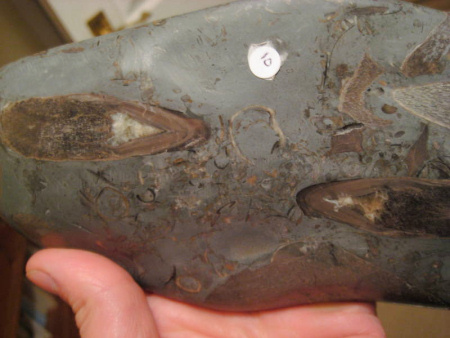
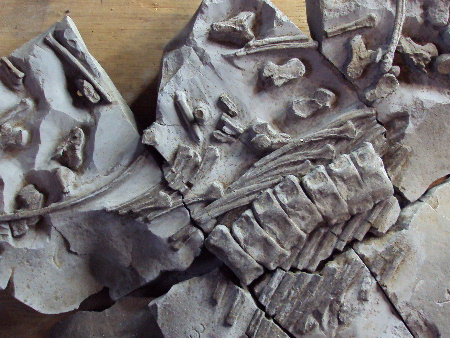
Left: A bone block appearing to contain ichthyosaur bones and teeth has been polished rather than more respectfully prepared. The result is minimally
informative and parts of the specimen have been lost. Better results can be achieved using an air-pen or an acid bath.
Right: A conscientiously hand-prepared ichthyosaur skeleton from Lyme Regis (Dorset), displaying all available anatomical information and retaining the
entire specimen. Manual preparation in the way requires significantly more hours of work, however the benefits are clear to see.
Introduction
In the following article attention is drawn to the benefits of conserving prehistoric evidence and how inappropriate collection, preparation, visual alteration and storage can have a detrimental effect. The aim is to highlight the features that contribute to a fossil's scientific value and promote the benefits of conserving these. Examples are provided to illustrate the actions that can result in a loss of evidence and therefore scientific value. The article is intended to share some of the personal insights and experience that Robert and I have gained over the years, and hopefully encourage best practice.
Fossil conservation is often a controversial subject and one that involves aspects of personal preference, i.e. what one person considers beneficial another considers detrimental. Similarly, what an enthusiast considers good practice typically changes with time, increased knowledge & understanding and access to specialist equipment. There are no strict guidelines for fossil conservation - individuals are largely free to decide how they collect and conserve specimens, and where they reside, e.g. a museum, private display, attic, etc. We too have experienced the same change in views and share the pain of some early prep jobs - below are some examples that are best not repeated.
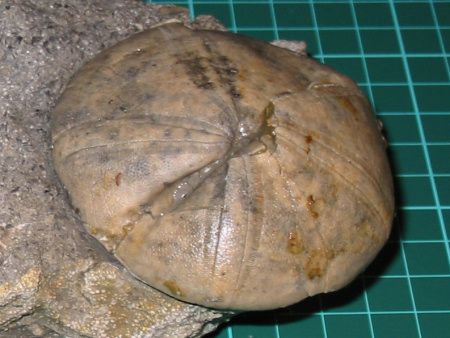

Left: A Clypeus ploti
echinoid from Woodeaton Quarry (Oxfordshire). Although the matrix
(surrounding rock) has been carefully reduced to expose the specimen,
a surface lacquer has then been applied in an attempt to enhance the aesthetics. Such practice obscures important surface details and generally results is a
misleading appearance that lessens the specimen's appeal. Good
scientific practice would have been to leave the surface in a natural / unaltered state.
Right: An Androgynoceras
ammonite from Seatown
(Dorset) partially exposed at the surface of a
nodule. To reveal an ammonite such as this, an air-pen
provides
the necessary power and precision for an effective outcome. Unfortunately however, at the time of preparing this particular
specimen such tools weren't easily
accessible. Consequently it was thought possible to tackle the preparation with
a sharp blade - the result was a damaged specimen that
was ultimately discarded.

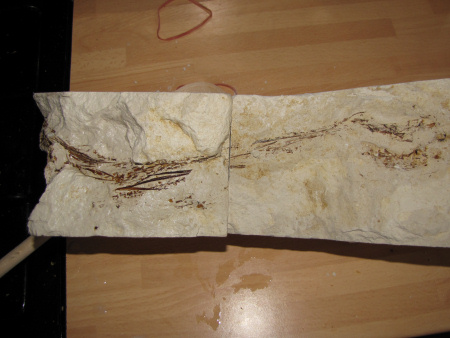
Left: A Temnocidaris sceptrifera
echinoid residing at The Booth Museum in Brighton. Although a
beautiful and near complete specimen, the preparation has
removed too much chalk matrix resulting in an overly fragile
specimen. A more robust plaster backing is now planned to provide stability of the specimen.
Right: An articulated Leptotrachelus chalk fish from
Seaford Head
(East Sussex) is mistaken for a Terebella (a crustacean
burrow lined with fish scales/bones)
and decapitated during extraction. Only after the portion containing the skull had been removed was the
error recognised. A little more patience and
consideration
may have
allowed time to recognise the specimen, thus avoiding the ensuing damage. The two
halves have been reunited, but the
damage can never be undone;
however, careful reconstruction and application of a chalk-based
'filler' will effectively disguise much of the visible damage.
The basic conservation issues usually relate to aesthetics, commerciality, knowledge and skills / experience. Both amateurs and commercial collectors are prone to collecting and preparing specimens in ways that emphasise their aesthetic qualities. This is not necessarily damaging to a specimen, but often can be. Examples include rare articulated vertebrates being collected as small pieces, e.g. collecting only the heads because the body is preserved in a 'less impressive' state or difficult to retrieve. This overlaps with commerciality – often decisions on how/what to collect and how to prepare are based on cost effectiveness. For example a fragile chalk fish might require several weeks of prep, but this isn't commercially viable; an ammonite might not ‘pop’ well, so easier to slice it; a crushed outer whorl of an ammonite is unsightly, so remove it; the matrix around an echinoid might be tough, so crank-up the air abrasive, stripping the surface detail in the process! Also, the lucky beginner may discover a specimen they simply don't know how to collect and conserve – stories of bits being hacked off skeletons because they were ‘too big to collect whole’.
Below we discuss the fundamental concept of treating fossils and fossil locations with respect and understanding how and when to take appropriate action. Attention is drawn to knowing your limits - some finds warrant professional preparation or simply waiting until you're better experienced or equipped. Good preparation requires an understanding of how the fossil material and matrix behaves, the different techniques and equipment needed, and also an understanding of the anatomy of the specimen and its general scientific value. Someone who collects regularly from a particular rock formation can quickly acquire this knowledge and experience, and even become a recognised expert. There are many places a new collector can seek advice on the scientific value of specimens and how they're best conserved, these include local geology groups, museums, discussion forums, commercial preparators and the Discovering Fossils team. We're always happy to answer questions, offer advice and put people in touch with the relevant professionals.

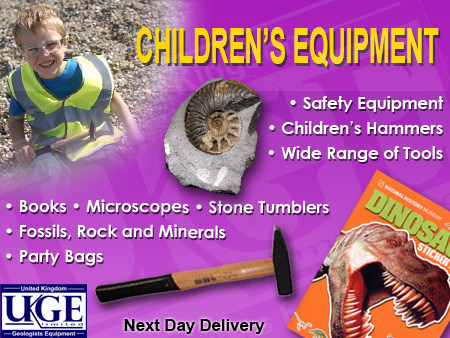
ADVERTISEMENT BY UKGE - OFFICIAL ADVERTISING PARTNER OF DISCOVERING FOSSILS
Prehistoric evidence
For many people their first appreciation of fossils was for their aesthetics, perhaps as a child stood gazing up at a dinosaur skeleton in a museum, or admiring an ammonite through a shop window. It's easy to understand the appeal of a well presented fossil - we appreciate the skilful work undertaken to expose it and it helps us imagine how the organism once lived. Of course there's nothing wrong with this, we should admire fossils in this way, but we should also consider the science too. Similarly, we should show respect for the ancient and scarce in the same way we would a Roman mosaic or Renaissance painting for example.
The science of palaeontology involves the interpretation of prehistoric evidence and to be of greatest value it needs to be as unaltered as possible. Manual preparation should seek to reveal and conserve the evidence available, with aesthetic preferences confined to the presentation of the surrounding rock (matrix), in this way the conservation of the evidence always takes priority.
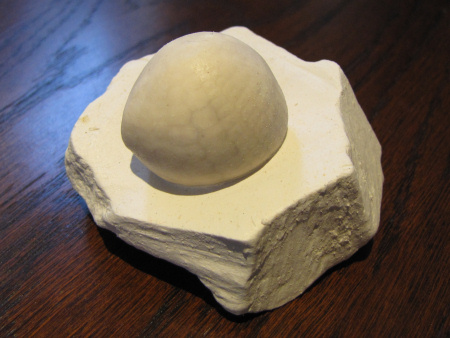

Left: This Offaster from
Peacehaven
(East Sussex) has
been conserved with the chalk matrix in order to
capture associated information about the prehistoric
seabed. Without the matrix it's often impossible to tell what formation
the specimen have come
from, where they came from and even what age they are.
Right: A cupedid beetle (12mm) from Smokejacks Brickworks
(Surrey). The head remains
obscured within the matrix until a means of revealing it
without
risking the specimen can be found. It's good practice to
resist the temptation to prepare/expose fossils in the field, better
to
undertake preparation at home.
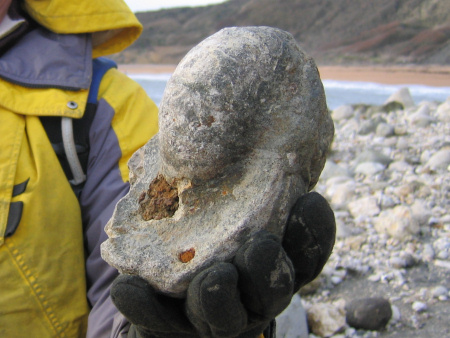

Left: Despite its beach-worn surface this
nautiloid from Osmington Mills
(Dorset) comprises
a large portion of the original specimen and we would argue is
best
conserved as found. The aesthetics are perhaps unsightly and common
practice would be destructive modification to improve its appearance
/ commercial value.
Right: A display of chalk fossils in the Booth Museum in Brighton.
The specimens have been carefully prepared and conserved in their
natural state.
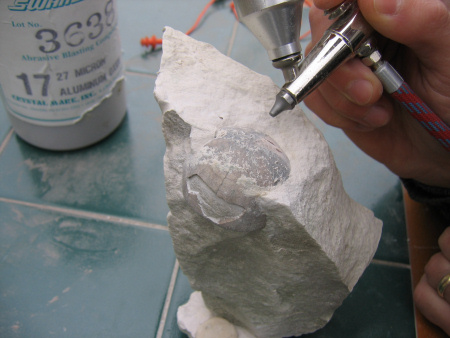

Left:
An air-abrasive tool being used to expose the surface of this echinoid
from a Lewes (East Sussex) quarry. The matrix is retained for environmental context.
Right: A close-up of the
air-abraded surface of the echinoid reveals
the often absent spines which covered the specimen in life. A more
aggressive
preparation
technique, e.g. a pen knife, would have removed these in an
instant.
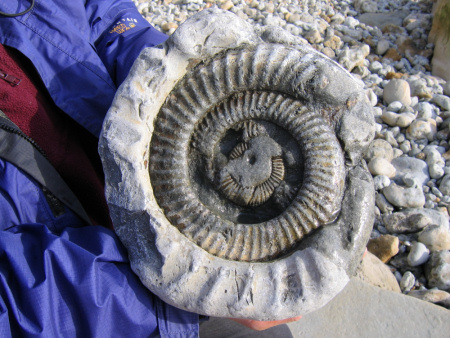

Left: The outer
whorl of this ammonite from Osmington Mills (Dorset) is worn and
some might say 'unsightly', arguably though this feature is best
conserved.
Right: This nodule from
Seatown
(Dorset)
contains Androgynoceras ammonites and ichthyosaur
vertebra, and we would argue best conserved together
as an association.

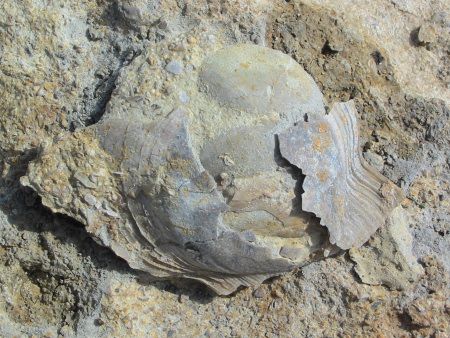
Left: A
Goniopholis crocodile tooth and surrounding matrix from
Durlston
Bay (Dorset), the latter contains plant debris which can help confirm the
environmental
setting and the age - in this instance an ancient lagoonal setting dating
from the Early Cretaceous Epoch, approximately 140 million years ago.
Right: A Clypeus ploti echinoid from
Woodeaton quarry (Oxfordshire) partly obscured beneath a broken
bivalve shell. Like the examples above the bivalve adds
environmental, depositional and ecological context to the echinoid and vice versa.
Fossils not only provide evidence of the organism itself but often the taphonomic processes during the interval between death and long-term burial, e.g. scavenging and encrustation. For example, a heavily encrusted specimen reveals the specimen lay exposed on the seabed for sufficient time that marine organisms colonised its surface. Furthermore, it also reveals the seafloor was oxygenated and provides clues to the specimen's orientation. This added contextual information enriches our interpretation of the prehistoric environment in which the specimen once lived. When preparing a specimen it's worth conserving any surface features for the environmental and/or biological context they add.
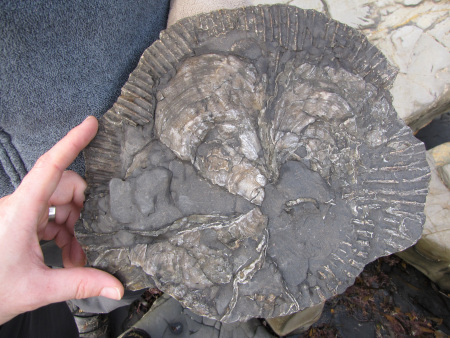

Left: This Pectinatites ammonite from
Kimmeridge (Dorset) is
partly obscured by pyritised oyster shells. The presence of the oysters
indicates the ammonite
lay exposed on the seabed for a sufficient time for them to colonise
its surface (possibly the underside). The oysters are part of this specimen's
history.
Right: Divers investigate a 'recent' shipwreck. The surface of the
wreck is heavily encrusted providing evidence of how long the ship has lain
on the seabed.
Like the fossil examples discussed the shipwreck encrustations are an equally important
feature and add to our understanding of the past.
The partial ammonite shown below could easily be overlooked, however this particular specimen features good examples of marine encrusters that colonised the inner surface of the shell. From this we can deduce that soon after the ammonite's death its shell sank to the seafloor where it acted as an underwater cave providing shelter for a variety of organisms, in particular tube-worms. Comparisons with present-day encrusters allow us to draw information concerning oxygen and temperature conditions on the seafloor. We can also ascertain that sediment accumulation took place slowly i.e. the shell lay exposed for sufficient time for encrusters to colonise it. The fact that the ammonite's aragonite shell dissolved, whilst the worm tubes are preserved (as calcite) on the surface of the mould also informs us about the seabed chemistry.

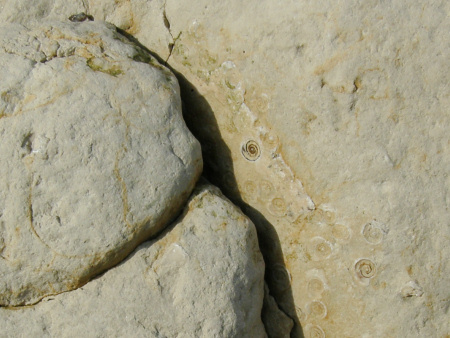
Left: A chalk boulder from
Beachy Head
(East Sussex) containing the partial internal mould of a large
ammonite shell - the shell has
naturally dissolved.
Right: A close-up reveals the internal shell
surface (preserved at the surface of the boulder) was colonised by
tube worms, their spiral shells clearly visible.
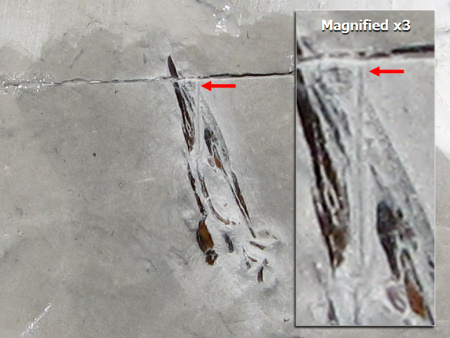
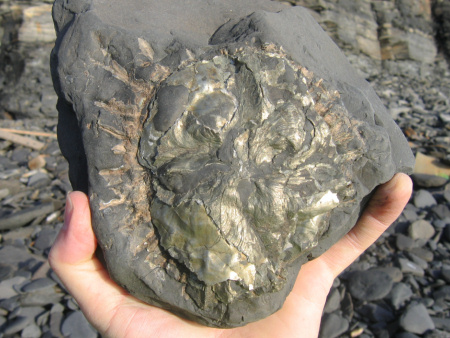
Left: The skull of a
Leptotrachelus fish, found within the Plenus Marls at
Beachy Head (East Sussex).
Note the echinoid spine retained for biological context.
Right: An ammonite obscured by pyritised oyster
shells, found loose on the beach at
Kimmeridge (Dorset). The oysters add to the
interest of this specimen.


ADVERTISEMENT BY UKGE - OFFICIAL ADVERTISING PARTNER OF DISCOVERING
FOSSILS
Collection practices
The following section discusses the collection practices that can help conserve prehistoric evidence and conversely the actions that can result in its loss. Often, decisions at this initial stage have the greatest impact on the lasting scientific value of the specimen i.e. only what's collected can be prepared and interpreted. The focus here is on the value of retaining the matrix during extraction and also the benefits of collecting the specimen whole, or if broken, retrieving all the pieces available. For an introduction to basic fossil collecting practices please refer to our Fossil Hunting Guide - here you'll find more information about legalities, extraction, transportation and recording key information in particular.
Retaining matrix: Matrix is the general term used to describe the associated rock that surrounds a fossil, and its retention has a number of benefits. First and foremost the matrix helps conserve the fossil by acting as a protective shield, without which it may be vulnerable to damage during transportation and storage/display. It's worth keeping in mind the balance between removing sufficient matrix to expose the fossil and the added risk exposure creates. Retaining a generous amount of matrix during extraction is recommended especially around the most fragile parts. The retained matrix can also be shaped to provide a stable base to display the specimen after the detailed work is complete.
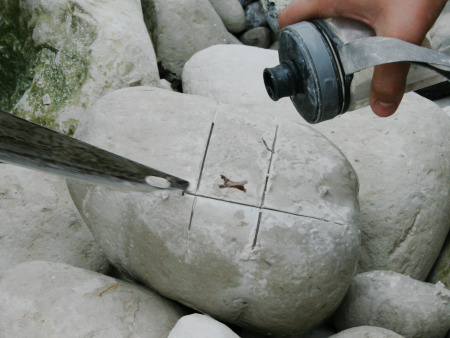
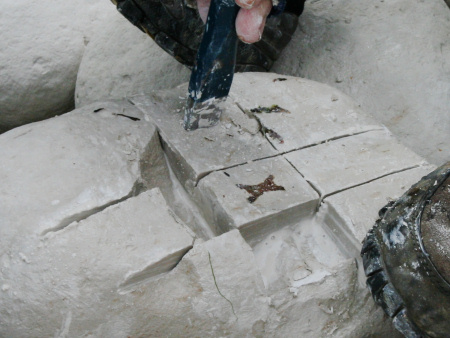
Left: In order to safely extract this fish
vertebra from a chalk boulder at
Beachy Head (East Sussex) a hand saw is used to make a series of cuts in the
matrix.
Water is added to assist the cutting action of the saw - it prevents the sediment
clogging the cutting line, reducing friction and therefore the
likelihood of the saw
jarring and shattering the specimen. It's good practice to carry
a small bottle
that can be topped-up with seawater or preferably fresh if
available.
Right: A chisel is then used to remove the excess
matrix, leaving the vertebra and a rectangular piece of matrix in
the centre which can be safely extracted.

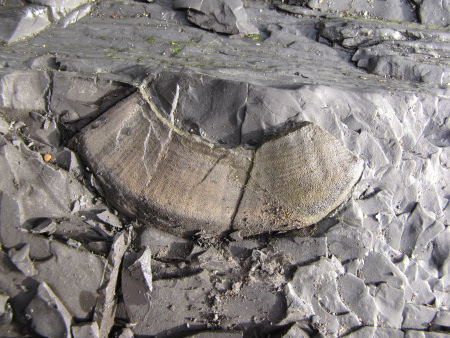
Left: The pieces of matrix surrounding this
Liparoceras ammonite from
Seatown (Dorset) have been recovered in
order to reattach any
shell fragments.
Right: An ammonite anaptychus ('closing
hatch') in situ near
Kimmeridge (Dorset). Retaining the matrix
during extraction helps provide long-term stability
to the specimen.
Matrix also provides useful information about the environmental processes and organisms present at the time of burial. For example, the chalk matrix associated with the fish vertebra (shown above) reflects a marine sediment deposited far from land, largely free of terrestrial sediment that would otherwise have coloured it. The chalk matrix also contains additional fossil material, including fragments of bivalve shell, bryozoan skeletons and microscopic foraminifer and nannofossils that can help date the specimen in the event of the recorded information being misplaced. The matrix may also preserve sedimentary structures relating to how the specimen came to be preserved, e.g. rapid burial - an often poorly understood process.
Retrieving all of the specimen: An association of prehistoric evidence is always of greatest value when collected whole, or when all the pieces are available together. As a general guide there are few instances where retrieving the specimen in pieces (unless broken already) is the best strategy; far better to retrieve the specimen complete. Where a specimen has broken, it's typically best to retrieve all the matrix blocks so it can be seamlessly reassembled.
In the example below-left, a Nymphaster starfish is found exposed at the surface of the Plenus Marls at Beachy Head (East Sussex). The complicated position of the specimen and existing faults passing through it, mean a dissection is unavoidable. Over the space of several hours the individual pieces were carefully removed, being mindful to collect any matrix that may contain parts of the starfish. At home the individual pieces were soaked in fresh water to remove the salt, then reassembled and a plaster backing added to provide extra support. The result of collecting all the pieces is soon evident as the full extent of the fossil appears during further preparation (see photo below-right).
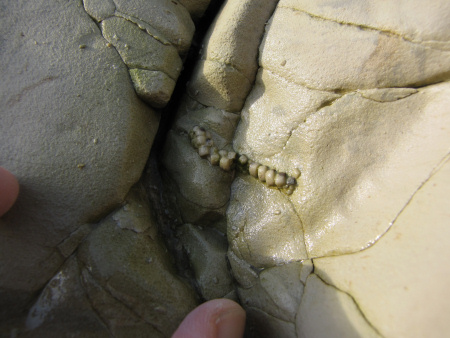
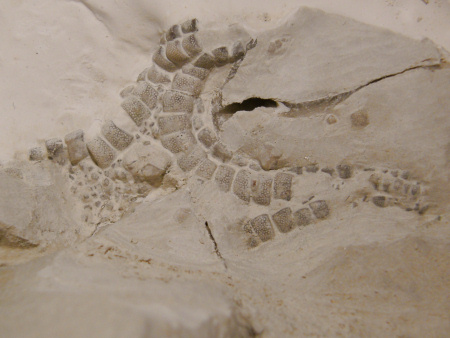
Left: A Nymphaster starfish exposed at the
surface of the Lower Chalk, Plenus Marls at Beachy Head (East Sussex). Note the
numberous natural cracks passing
through and around the specimen. Dissecting the specimen along these
existing cracks in unavoidable in this instance.
Right: Having been reassembled and a plaster
backing added (visible at the top of the photo), the next step to
expose the starfish can begin. The photo shows
the early results, with two of the creature's arms visible at the
top and right of the photo. Further preparation will reveal if more
of the specimen is present.
Often however, specimens may suffer intentional dissection, perhaps because part of the specimen was out of reach or obstructed making a thorough extraction more difficult or time consuming. In a worst-case scenario only the parts of the fossil perceived as having greatest value are retrieved, leaving the remaining pieces behind. Often the problem results from having inadequate tools/experience or extracting the specimen too hastily. In the example below dissection resulted from a failure to recognise the significance of the find until it's too late.
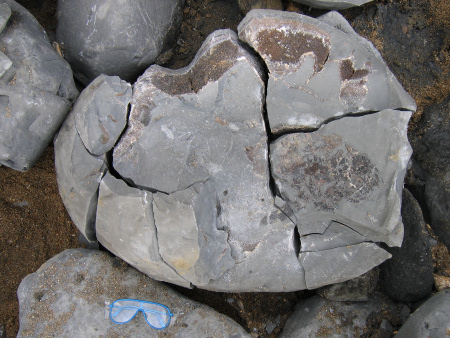

Left: A large septarian nodule on the beach at
Charmouth
(Dorset) containing
the complete and articulated remains of a large and scarce Early Jurassic
fish
(note goggles for scale).
A commercial collector broke up the boulder but
rejected the specimen not considering it to be commercially viable.
One of the
Discovering
Fossils team
reassembled the pieces and then returned to the
nearby conservation centre for help retrieving the specimen from the beach. During
those few minutes a local collector took the lazy option and broke off the head and fins, inflicting irreparable damage to the specimen.
Right: The outline suggests how the specimen would have
looked
if preparation had taken place and shows what a significant specimen it was.
In the following example a rare articulated ichthyosaur paddle was unknowingly broken apart by an inexperienced collector and rejected. Despite the devastation the significance of the various pieces was recognised by a passing father and son who conscientiously gathered the pieces so they could be reconstructed. After many hours of painstaking work the resulting outcome is plain to see - the arrangement of the bones depicts their life positions and provides a fascinating insight to how these creatures propelled themselves through the water.
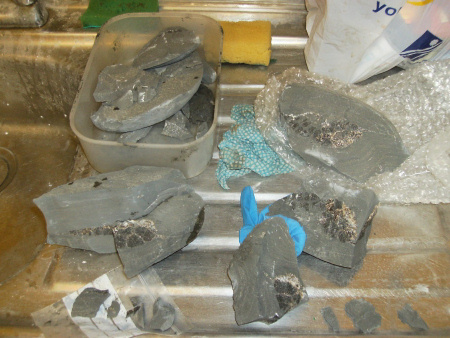
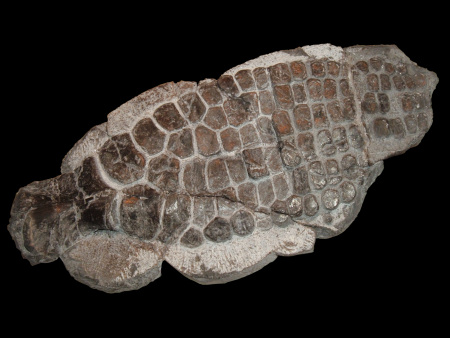
Left: A broken septarian nodule found on Monmouth Beach at
Lyme Regis (Dorset) containing
the articulated bones of an ichthyosaur paddle - seen here as dark
areas against the grey limestone. The specimen was presumably
smashed by an inexperienced visitor who subsequently rejected the
specimen. Fortunately the
pieces were rediscovered by a father and son who recognised their
significance and gathered the fragments in order than they could be
reassembled.
Right: After many hours of painstaking
reconstruction, using only hand tools, the splendour of the
discovery is plain to see. The humerus can be
seen at the far left of the specimen, connected to which are many
articulated phalanges that make up the paddle.
The ichthyosaur example (above-left) graphically illustrates the danger resulting from a lack of subject familiarity, and perhaps more importantly knowing when to halt hammering and reassess the situation or seek advice. It's often the case that the significance of a find only becomes apparent part way into the extraction i.e. when it's evident there's a degree of order to the bones for example.
Perhaps the most high-profile example of a dissection in recent years involved one of the principle dinosaur trackways at Ardley quarry (Oxfordshire) prior to the site's protection in 2010. Following the discovery of the trackways in 1997 Ardley has attracted international interest, partly due to the high volume and length of trackways exposed, but also because one in particular (thought to belong to a Megalosaurus) revealed how the dinosaur accelerated from walking to running. Perhaps this was evidence that the dinosaur has been stalking its prey prior to launching a high speed attack? This unique trackway began with a stride length of 2.7 metres while walking at 7 km/h, increasing to 5.5 metres when running at 30 km/h. Furthermore the footprints revealed that whilst walking the dinosaur splayed its feet out widely with the toes pointing inwards, whereas when it ran it tucked its feet beneath its body.
Although the early conservation of the trackway was sufficient to allow time for numerous visits, studies, and a plaster cast to be taken, the site eventually suffered damage from quarry vehicles and weathering. In an effort to conserve a small number of the remaining footprints, the trackway was dissected and the removed pieces placed on display at the Oxfordshire Museum. Much credit is due to the work of the museum for creating a fascinating display that will no doubt be of great public interest. Unfortunately, the current display fails to conserve the features that made the original discovery of unique importance. The four isolated footprints displayed are orientated parallel to each other and provide little indication that they once belonged to a trackway. Perhaps at some point in the future the footprints will be realigned into a trackway and some of those missing parts reconstructed to restore the features most important to the original discovery.
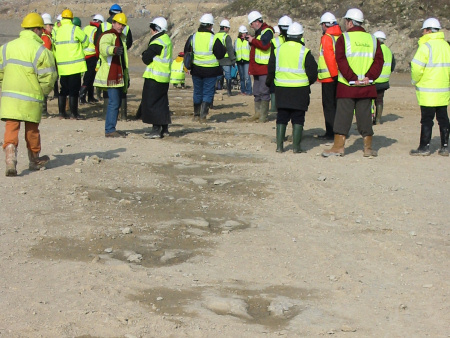
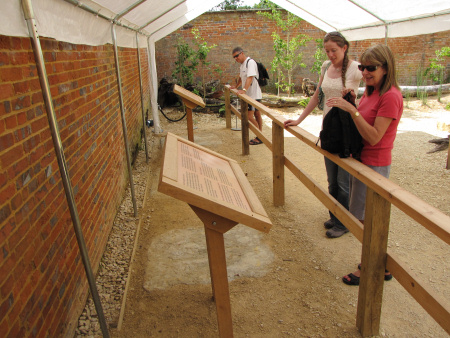
Left: One of many incredible dinosaur trackways
discovered at Ardley Quarry in Oxfordshire. The position and spacing
between the footprints of this principle
set, thought to belong to a Megalosaurus, provided a unique insight into the
way these ancient reptiles walked and ran. Despite its
significance much of the
trackway was inadequately conserved and eventually destroyed. Original
in situ photos
for reference:
high-res photo 1
high-res photo 2
high-res photo 3.
Right: A small number of the dissected footprints
are displayed at the Oxfordshire Museum. Despite much credit being
due to the museum, the display conserves
little of what made this discovery important. Most
of the trackway is missing and what footprints are featured are
incorrectly orientated.
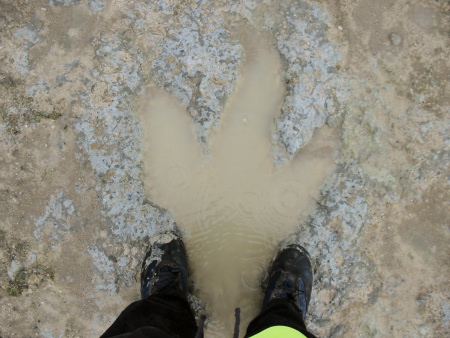
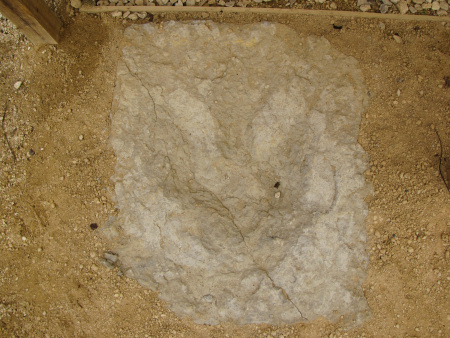
Left: One of the 'Megalosaurus' footprints
in situ at Ardley in 2002. The rain that day had
accumulated in the prints creating a scene reminiscent of Jurassic
Park!
Right: The same(?) footprint displayed at the
Oxfordshire Museum in 2010 - it appears to resemble the footprint
featured (left).
In our view the Ardley case illustrates a tremendous loss of scientific evidence despite the details of the original trackway being recorded. Fortunately the remaining trackways are now protected to avoid further unnecessary loss.
Preparation practices
Having collected the specimen the next stage concerns its preparation to reveal the evidence available and ensure its long-term stability/durability. As above, decisions here can greatly affect the scientific value of the specimen - too little preparation and the information available may remain concealed; too much preparation and the specimen may become overly vulnerable to accidental damage. The following section discusses some of the common 'enhancements' and 'adaptions' that can cause irreversible damage, and are therefore best avoided.
Varnishing: Many collectors have considered or have applied a varnish/lacquer to fossils at some point in the past, often in the early stages of collecting. Varnishing offers some benefits including strengthening fragile specimens and 'enhancing' the specimen's appearance, the latter of which is a matter of personal preference. Without easy access to superior alternatives, e.g. Paraloid B72, a varnish/lacquer can appear a good substitute.
Unfortunately, the application of varnish has a number of drawbacks - it obscures surface details, creates an artificial appearance, restricts future preparation and repairs, is difficult to remove without damaging the specimen and limits the appeal to fellow collectors.
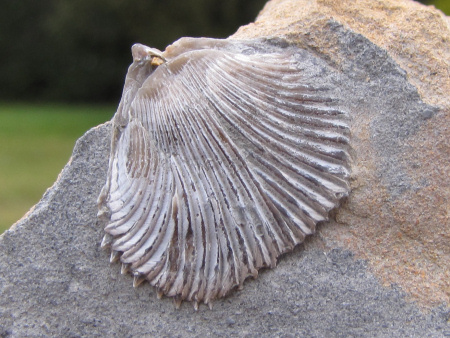
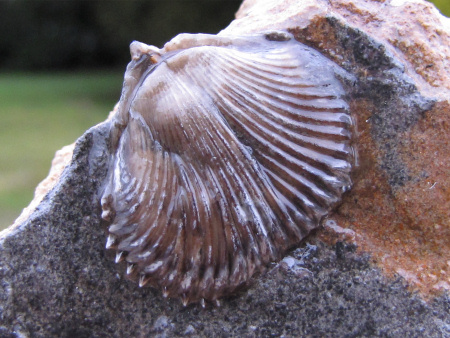
Left: A brachiopod from Woodeaton Quarry
(Oxfordshire). In its natural state the specimen and surrounding
matrix allow every detail to be clearly visible.
Right: The same specimen with a clear varnish
applied to the surface. Many of the subtle surface textures have been
obscured, along with much of the shell.
Generally speaking a surface coating is unnecessary, if handled with care and stored in a safe, dry place most fossils will be stable in the long-term. Exceptions include some specimens preserved as iron pyrite for example, which are susceptible to oxidisation. When pyrite (FeS) oxidises the reaction produces sulphuric acid (H2SO4) as a by-product. This acid then reacts with a much greater variety of materials, eventually dissolving the entire fossil. A transparent lacquer in this instance may delay/slow the rate of decay. An alternative and recommended technique for unstable pyrite specimens is to store them in a sealed bag accompanied by a sachet of silica gel; experienced collectors may also use ammonia to halt the decay.
Polishing: A practice to generally avoid is surface polishing, usually associated with mass market fossils for sale, in particular cephalopod shells, e.g. ammonites, nautili and orthocones. Polishing typically seeks to increase the visual contrast of surface structures, or reveal the internal fabric of the fossil - for example the spiralling chambers of an ammonite shell. Some claim polishing restores the fossil to how it might once have looked, but this is rarely the case. Polishing is irreversible and the process removes the fossil's outer surface, losing much of the specimen and any associated environmental/biological evidence in the process.
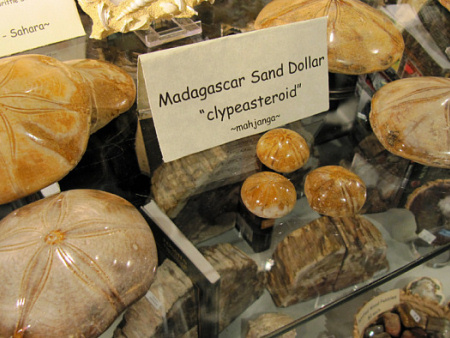

Left: A collection
of polished clypeasteroid 'Sand dollar' echinoids from Madagascar.
Polishing has removed much of the finer details at the surface of
the test.
Right: A well presented Menopygus nodoti
echinoid displaying the intricate surface tubercles to which the
spines attached in life.
In the example above the surface of the echinoid's shell is beautiful and complex, the subtle details of this patternation are often key to identifying the species, and also understanding how it lived. The pores, tubercles and aureoles record the complex array of spines and other body parts that were present on the outer surface of the echinoid in life. Polishing irreversibly obliterates this information.

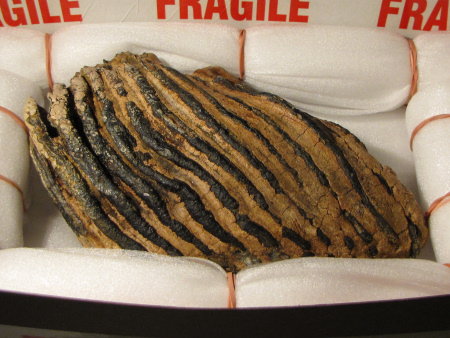
Left: This mammoth tooth may feature beautiful internal
structures, but polishing has removed much of the fossil and with it much
of its scientific value.
Right: For comparison, a mammoth tooth from Colne Quarry. The specimen has been carefully cleaned and strengthened with a dilute concentration of
Paraloid B72 (5%), without which the tooth would likely break. Preparation
in this way conserves the intricacies of the tooth and therefore the scientific value.
Arguably there are some benefits to polishing certain fossils, for example fossil bearing limestone quarried for the manufacture of kitchen surfaces and other household items. Similarly there's no significant loss caused by polishing some fossils for display, e.g. exceptionally abundant Moroccan orthocone nautiloids, as doing so provides some aesthetic and educational benefits and their widespread distribution as ornamental pieces helps raise public familiarity with fossils. Amber containing fossilised organisms is also an exception, without which the internal fossils would be obscured. However a distinction should be made between polishing common fossils and applying the same technique to fossils of greater scientific value. As a general rule it's best to avoid polishing specimens that can be conserved and presented in their natural state.
Slicing: Among the most controversial practices is the slicing of prehistoric evidence to reveal the internal structure, often undertaken in conjunction with polishing. There are instances where slicing can be beneficial i.e. the loss is outweighed by the aesthetic and/or educational benefits. For example, a heavily worn, common ammonite shell where the surface is beyond recognition and offers limited value in its present state - slicing in this instance might reveal the internal mineral-filled chambers of the shell. Similarly a specimen may be sacrificed within a laboratory in order to expand our understanding of a particular species, e.g. slicing dinosaur bone in an attempt to inform the ongoing hot-blooded vs cold-blooded debate. Similarly some fossils, e.g. foraminifera, are routinely sliced by academic palaeontologists, as doing so is the only effective means of identifying them.
In practice, slicing isn't confined to the examples above. The commercial market in particular is awash with specimens that were arguably of greater value in their complete state. For example, it's not uncommon to find associated vertebrate bones sliced and sold as separate specimens. An association of bones may require many more hours to prepare scientifically than to cross-section for sale. Similarly, the sliced parts may collectively generate more revenue than the original complete specimen, especially if the original specimen's appearance narrows its appeal.
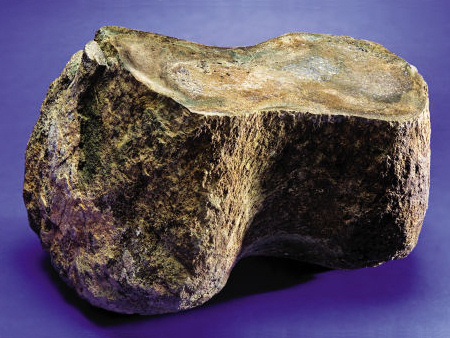
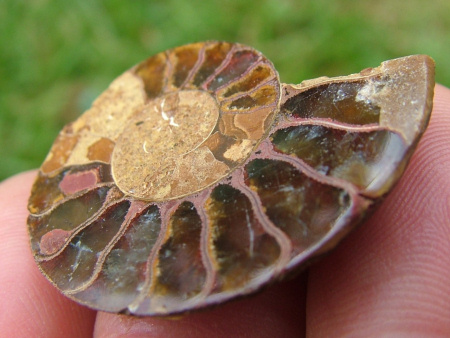
Left: This sliced
'dinosaur leg bone' for sale online, once belonged to a
more complete specimen that was destroyed in the process.
Right: This common ammonite
is typical of the sliced and polished fossils available for sale around the
world. Its preparation in this way is less controversial.
As a general guide it's best to avoid slicing in the majority of instances. Often the outcome of slicing is disappointing as the internal structure is neither aesthetically pleasing nor educational, resulting in an unappealing specimen. A fossil is rarely of greater scientific value when sliced than in its complete state.
Modification: Most collectors have ‘improved’ specimens at least slightly, be it filling in cracks or painting over a small chip. On a small scale this is usually quite harmless and can help retain the visual appeal of a specimen without altering the anatomical information. Opposite extremes are widely seen in the commercial market, where composite specimens are abound, and fossils are routinely carved to enhance their appearance. There is a large grey area between the extremes though, and it's often hard to know when you've ‘gone too far’. For example, it's common to see the centre of an ammonite carved in. This is a ‘constructive’ modification where no actual harm has been done, but it does serve to confuse the anatomical story – many academic palaeontologists have been fooled by an artfully improved fossil. A more controversial practise is destructive modification, such as the removal of ‘unsightly’ outer whorls on ammonites, which are often crushed. This constitutes real loss of information and should only be acceptable for the very commonest fossils.
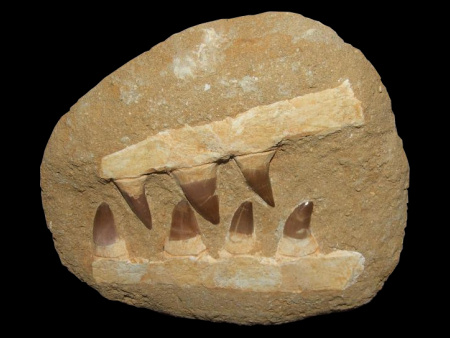
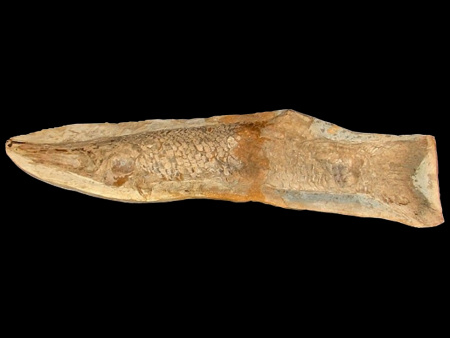
Left: An extreme example of a modified
fossil. Isolated fragments of Moroccan mosasaur(s) have been
combined to appear to be a single specimen.
Right: The fossils of the Brazilian Santana
Formation provide many classic examples of 'improved' fossils. Here
sections of two unrelated fish have been
combined, and a dorsal fin carved in to give the impression of a
single fish.


Left: At first glance this chalk fish appears to be
an exemplary prep job, until that is you notice the scales are absent -
seemingly removed by the Victorian
preparator in an example of destructive modification. It appears
the desire to reach the bones took precedent over conserving
the full specimen.
Right: An equivalent example where the scales have
been respectfully retained. The scales are typically very fragile
and require great skill and patience to prepare.
Over preparation: For certain fossils (typically spiny ones), it's tempting to remove large amounts of matrix to achieve a spectacular display piece. Most people are familiar with Moroccan trilobites, which can be wildly ornamented. As well as looking stunning, the preparator’s skill has also exposed the full anatomy of the fossil; however, the downside is the extreme fragility of these specimens which all seem destined to be damaged. For abundant forms like the Moroccan trilobites this is probably a justified risk, but for rarer fossils this should be avoided. The echinoid figured below is an example of what typically befalls an over prepared specimen at some point. An example is also figured in the introduction at the top of the page, where a specimen prepared by one of the authors will need a plaster backing if it's going to survive undamaged in the future.
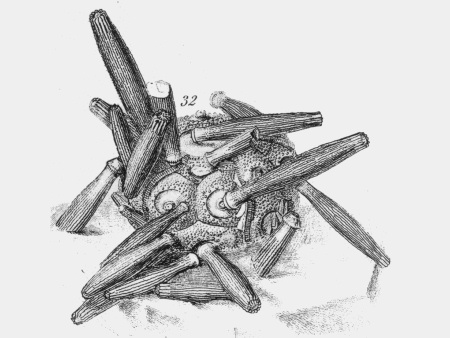
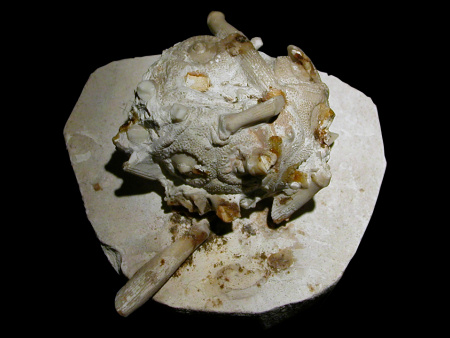
Left: This 19th century illustration captures this
scarce and stunning, but tragically over-prepared Hirudocidaris. Sadly this
example has since been poorly
stored and handled at some stage in its history.
Right: The same specimen in its present state of
disrepair, with much of the specimen lost. Thankfully it's now in
appropriate storage at the Booth Museum
in Brighton where no further harm should come to it. A more
conservative prep job would have improved this specimen’s chances of
surviving the centuries.
Storage practices
Safe storage: Of course, no matter how conscientious the collection and preparation, all can be lost if the method of storage fails to protect the specimen from damage in the long-term. Finding a balance between enjoying a specimen and limiting the risk of damage from movement and handling can be difficult. Many fossils are susceptible to breakage, especially if, as highlighted above, the matrix has been significantly reduced to expose the fossil. In the example below-left it's clear that suitable storage arrangements have been neglected, consequently areas of the echinoid's test are now absent presumed knocked off. For comparison the example on the right (stored at the Natural History Museum in London) illustrates how even specimens from very old collections can be protected.

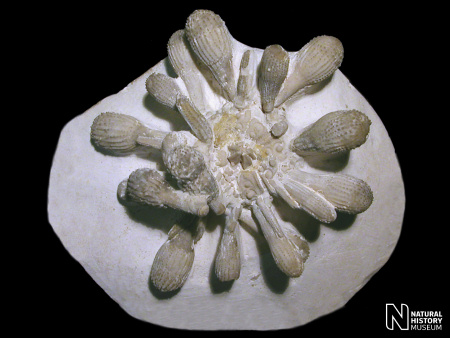
Left: This Hirudocidaris hirudo echinoid appeared
for sale on EBAY. The specimen has suffered a brutal prep job that has
undermined many of the features.
Such a rare association of the echinoid's test and spines deserved careful
preparation and suitable storage, the latter of which appears to have been
neglected.
Right: A well presented Tylocidaris echinoid. The
chalk matrix has been carefully prepared to expose the specimen and provide
support to the fragile features.
Image provided by the
Natural History Museum © 2010.
Recording information: Labelling of specimens is critical if they're to retain their scientific value. This should include location as a minimum, and ideally details of the source horizon / formation such as is known. For evidently significant specimens collected in unfamiliar locations, information should be quickly sought on the local stratigraphy so that the specimens stratigraphic context can be established whilst the information is fresh in the collector’s mind. It's less important to display the identification of a specimen, as this is subjective and names are subject to change. It's usually possible to attach a specimen number to even a small specimen, which can then be related back to a collection catalogue. Ideally a full description label can be attached to the reverse side of the matrix, but this is often impractical.

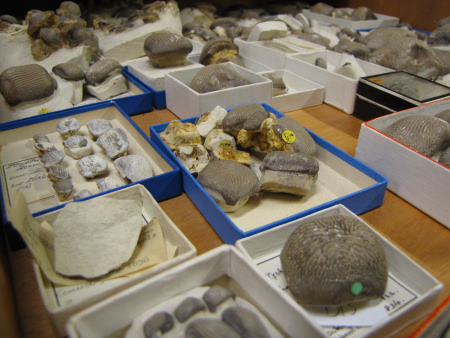
Left: Specimen drawers at the Natural History Museum
in London. The fossils are arranged into draws by rock formation /
age and then genus. There are no
strict guidelines for how a private collection should be arranged,
rather it simply needs to be organised to provide easy access to the
specimens.
Right: Within the draws specimens are labelled and
stored within suitably sized cardboard trays to prevent them coming
in contact with one another.

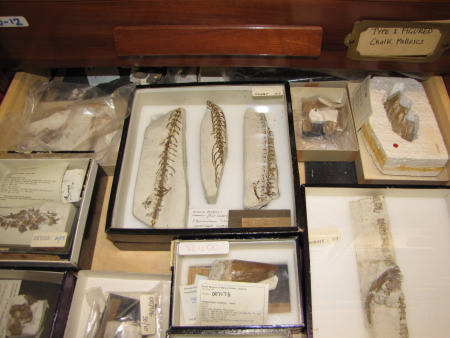
Left: A collection of ammonites for sale in a shop
window. The absence of any matrix or recorded information, e.g. local origin,
rock formation, species etc.
makes identifying them more complicated. It's generally good practice to
accompany your finds with as much information about them as possible
read
more.
Right: A drawer of chalk fish at the
Booth Museum, each specimen accompanied by an information slip
documenting their specimen number, and in
some examples the source location, species etc.
Further information and support
If you have a comment or question please contact us using the link at the top of the screen. We're happy to provide independent advice on a range of subjects including conservation, preparation and the protection of locations/fossils of scientific value. If we're unable to answer your questions we have a network of academic and professional contacts who will be able to help you further.
Join us on a fossil hunt
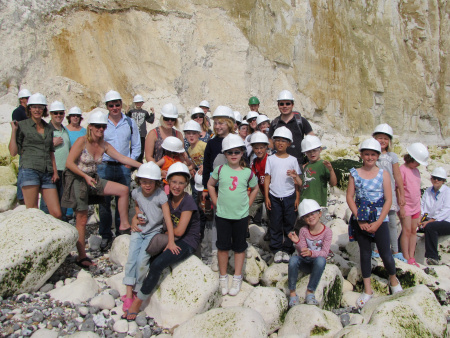

Left: A birthday party with
a twist - fossil hunting at
Peacehaven.
Right: A family hold their prized ammonite at Beachy Head.
Discovering Fossils guided fossil hunts reveal evidence of life that existed millions of years ago. Whether it's your first time fossil hunting or you're looking to expand your subject knowledge, our fossil hunts provide an enjoyable and educational experience for all. To find out more CLICK HERE




